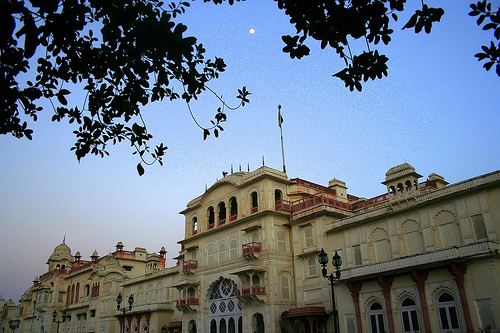 | ||
The state of Punjab is renowned for its cuisine, culture and history. Punjab has a vast public transportation and communication network. Some of the main cities in Punjab are Amritsar, Jalandhar, Patiala, Pathankot and Ludhiana. is known for the combines made here while Patiala is known for the historical forts. Punjab also has a rich Sikh religious history. Tourism in Punjab is principally suited for the tourists interested in culture, ancient civilisation, spirituality and epic history. Some of the villages in Punjab are also a must see for the person who wants to see the true Punjab, with their beautiful traditional Indian homes, farms and temples, this is a must see for any visitor that goes to India. Lonely Planet Bluelist 2008 has voted the Harmandir Sahib as one of the world’s best spiritual sites with over 100,000 pilgrims and tourists visiting on a daily basis. Since Amritsar is a big tourist spot, a lot of five star hotels are getting attracted to open up properties here. Hotel Ista has become very popular with nonresident Indian (NRI) community. New properties by Radisson and Taj are coming up in this city.
Contents
- Map of Punjab
- Wagah border
- Virasat e Khalsa
- Khatkar Kalan
- Hussainiwala National Martyrs Memorial
- Durgiana Temple
- Qila Mubarak
- References
Map of Punjab
Wagah border
Wagah (Punjabi (Gurmukhi): ਵਾਹਗਾ, Hindi: वाघा, Urdu: واہگہ) is a village situated near a road border crossing, goods transit terminal and a railway station between Pakistan and India,[1] and lies on the Grand Trunk Road between the cities of Amritsar, Punjab, India, and Lahore, Punjab, Pakistan.
The border is located 24 kilometres (15 mi) from Lahore and 32 kilometres (20 mi) from Amritsar. It is also 3 kilometres (1.9 mi) from the bordering village of Attari.
Wagah, named Wahga in Pakistan, is a village near which the accepted Radcliffe Line, the boundary demarcation line dividing India and Pakistan upon the Partition of India, was drawn.[2] The village lies 600 meters west of the Border line. At the time of independence in 1947, the migrants from the Indian parts of the subcontinent entered the present day Pakistan through this border crossing. The Wahga railway station lies 400 meters to the south and only 100 meters from the Border line itself. In Pakistan the Border crossing is known as Wahga Border whereas in India it is called Atari Border crossing, named after the Indian village Atari, which lies 500 meters east of the border line within Indian territory.
It is particularly known for the elaborate Wagah border ceremony that happens at the border gate, two hours before sunset each day.[2] The flag ceremony is conducted by Indian Border Security Force (BSF) and Pakistan Rangers (PR).
Virasat-e-Khalsa
Virasat-e-Khalsa (Punjabi: ਵਿਰਾਸਤ-ਏ-ਖਾਲਸਾ) is a museum of Sikhism. It is located in sri Anandpur Sahib, the holy town near Chandigarh, the capital of the states of Punjab and Haryana. It is situated at a distance of around 45 km from Chandigarh.
Khatkar Kalan
Khatkar Kalan is a village between Banga and Nawanshar towns in Shahid Bhagat Singh Nagar district in the Indian state of Punjab. This is the ancestral place of S.Bhagat Singh, the a well known freedom fighter of India. The district is named after his name, Shaheed Bhagat Singh Nagar.
Neighboring villages that share a boundary with Katkar Kalan are Thandian, Dosanjh Khurd, Manguwal, Karnana, Kahma, Bhootan, Bhukhari and the town of Banga
Hussainiwala National Martyrs Memorial
Hussainiwala (Punjabi: ਹੁਸੈਨੀਵਾਲਾ)is a village in Firozpur district in Punjab state, India. It is situate on the bank of the Sutlej river. Hussainiwala National Martyrs Memorial {(Hindi:हुसैनीवाला राष्ट्रीय शहीदी स्मारक, पंजाब, भारत)} is built here in memory of Indian freedom fighter Bhagat Singh, Sukhdev and Rajguru.
Durgiana Temple
The Durgiana Temple, Durga Tirath and Sitla Mandir, is a main Hindu temple of Punjab (India) situated in the city of Amritsar. Though a Hindu temple, its architecture is similar to the Golden Temple of Sikh religion. It is named after name of the Goddess Durga, the chief Goddess deified and worshipped here.
Qila Mubarak
Qila Mubarak inside view Qila Mubarak (Punjabi: ਕ਼ਿਲਾ ਮੁਬਾਰਕ, Hindi: क़िला मुबारक, Urdu: قلعہ مبارک), is a historical monument in the heart of the city of Bathinda in Punjab, India. It has been in existence from 90-110 AD in its current place and is the oldest surviving fort in India. It was here that Razia Sultan, the first woman to take charge of the Delhi throne was incarcerated on her defeat and dethroned. The bricks of the fort date back to the Kushana period when emperor Kanishka ruled over Northern India/Bactria. Raja Dab, along with emperor Kanishka, is believed to have built the fort.
